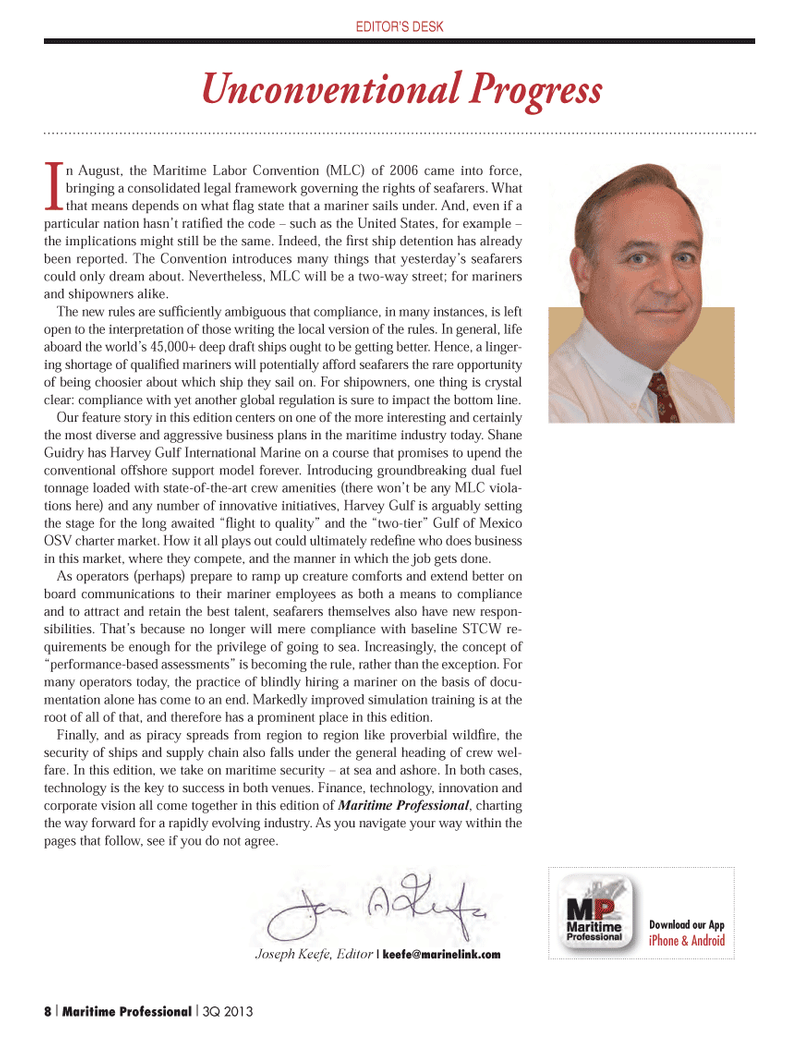
Page 8: of Maritime Logistics Professional Magazine (Q3 2013)
Training & Security
Read this page in Pdf, Flash or Html5 edition of Q3 2013 Maritime Logistics Professional Magazine
Unconventional Progress EDITOR?S DESK In August, the Maritime Labor Convention (MLC) of 2006 came into force, bringing a consolidated legal framework governing the rights of seafarers. What that means depends on what ß ag state that a mariner sails under. And, even if a particular nation hasnÕt ratiÞ ed the code Ð such as the United States, for example Ð the implications might still be the same. Indeed, the Þ rst ship detention has already been reported. The Convention introduces many things that yesterdayÕs seafarers could only dream about. Nevertheless, MLC will be a two-way street; for mariners and shipowners alike. The new rules are sufÞ ciently ambiguous that compliance, in many instances, is left open to the interpretation of those writing the local version of the rules. In general, life aboard the worldÕs 45,000+ deep draft ships ought to be getting better. Hence, a linger- ing shortage of qualiÞ ed mariners will potentially afford seafarers the rare opportunity of being choosier about which ship they sail on. For shipowners, one thing is crystal clear: compliance with yet another global regulation is sure to impact the bottom line. Our feature story in this edition centers on one of the more interesting and certainly the most diverse and aggressive business plans in the maritime industry today. Shane Guidry has Harvey Gulf International Marine on a course that promises to upend the conventional offshore support model forever. Introducing groundbreaking dual fuel tonnage loaded with state-of-the-art crew amenities (there wonÕt be any MLC viola- tions here) and any number of innovative initiatives, Harvey Gulf is arguably setting the stage for the long awaited Òß ight to qualityÓ and the Òtwo-tierÓ Gulf of Mexico OSV charter market. How it all plays out could ultimately redeÞ ne who does business in this market, where they compete, and the manner in which the job gets done. As operators (perhaps) prepare to ramp up creature comforts and extend better on board communications to their mariner employees as both a means to compliance and to attract and retain the best talent, seafarers themselves also have new respon- sibilities. ThatÕs because no longer will mere compliance with baseline STCW re- quirements be enough for the privilege of going to sea. Increasingly, the concept of Òperformance-based assessmentsÓ is becoming the rule, rather than the exception. For many operators today, the practice of blindly hiring a mariner on the basis of docu- mentation alone has come to an end. Markedly improved simulation training is at the root of all of that, and therefore has a prominent place in this edition.Finally, and as piracy spreads from region to region like proverbial wildÞ re, the security of ships and supply chain also falls under the general heading of crew wel- fare. In this edition, we take on maritime security Ð at sea and ashore. In both cases, technology is the key to success in both venues. Finance, technology, innovation and corporate vision all come together in this edition of Maritime Professional , charting the way forward for a rapidly evolving industry. As you navigate your way within the pages that follow, see if you do not agree. Joseph Keefe, Editor | [email protected] our AppiPhone & Android8 I Maritime Professional I 3Q 2013MP #3 1-17.indd 8MP #3 1-17.indd 89/10/2013 2:37:51 PM9/10/2013 2:37:51 PM

 7
7

 9
9
